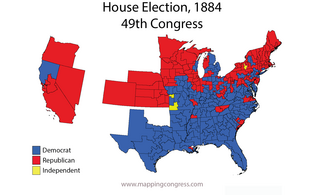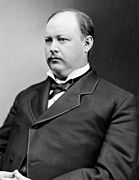| |||||||||||||||||||||||||||||||||||||||||||||||||||||||||||||||||
All 325 seats in the United States House of Representatives 163 seats needed for a majority | |||||||||||||||||||||||||||||||||||||||||||||||||||||||||||||||||
|---|---|---|---|---|---|---|---|---|---|---|---|---|---|---|---|---|---|---|---|---|---|---|---|---|---|---|---|---|---|---|---|---|---|---|---|---|---|---|---|---|---|---|---|---|---|---|---|---|---|---|---|---|---|---|---|---|---|---|---|---|---|---|---|---|---|
| |||||||||||||||||||||||||||||||||||||||||||||||||||||||||||||||||
 Elections results from the 1884 elections | |||||||||||||||||||||||||||||||||||||||||||||||||||||||||||||||||
| |||||||||||||||||||||||||||||||||||||||||||||||||||||||||||||||||
The 1884 United States House of Representatives elections were held for the most part on November 4, 1884, with four states holding theirs early between June and October. They coincided with the election of President Grover Cleveland. Elections were held for 325 seats of the United States House of Representatives, representing 38 states, to serve in the 49th United States Congress. Special elections were also held throughout the year.
In spite of Cleveland's victory, the opposition Republican Party gained back some of the seats lost in 1882, but the Democratic Party retained a majority in the House. Republicans were able to make these slight gains by connecting their pro-business and industry message with progress. The Democrats were also hindered by the Panic of 1884, but were not greatly affected by it since the depression ended quickly.
Cite error: There are <ref group=lower-alpha> tags or {{efn}} templates on this page, but the references will not show without a {{reflist|group=lower-alpha}} template or {{notelist}} template (see the help page).

